A Monumental Journey: Art & Architecture in Masonry
Words: Megan Rajner
Words:Megan Rajner
Photos: SeedorffMasonry
Celebrating a Moment in Time of Great Magnitude
“It was a monumental journey. It took us 12 years to get here, but we did arrive.” -Kerry James Marshall, Artist
The United States of America is filled with activists. Activists, who not only fight for what they believe in but also commemorate the milestones our country has reached as a people. Amidst the constant controversy in political, economic, and social scenes we see these people stand out - attempting to communicate with the rest of the world that these milestones hold more significance than a check on a list - they are moments in time of great magnitude worthy of a long fought for celebration.
Sitting in Hansen Triangle Park nearby the Des Moines’ Riverwalk in Iowa is a commemorative architectural installation that speaks to a moment in time- one certainly of great magnitude. This piece, known as A Monumental Journey, was designed by artist Kerry James Marshall to celebrate the legacy of the African American lawyers who founded the National Bar Association. The association was founded in Des Moines, Iowa in 1924 by 11 black men and 1 black woman who altered the history of law not only for the country but for the whole world.
Now representing the interests of approximately 65,000 lawyers, judges, law professors, and law students, the NBA is the nation’s oldest and largest national association of predominately African American lawyers and judges representing the United States, Africa, England, Canada, as well as the Virgin Islands. It was decided at the 75th Anniversary Celebration of the association in 2002 by NBA past president Evett L. Simmons and INBA past president Odell Mcghee, that something must be done to better honor the founders of the NBA and its achievements.
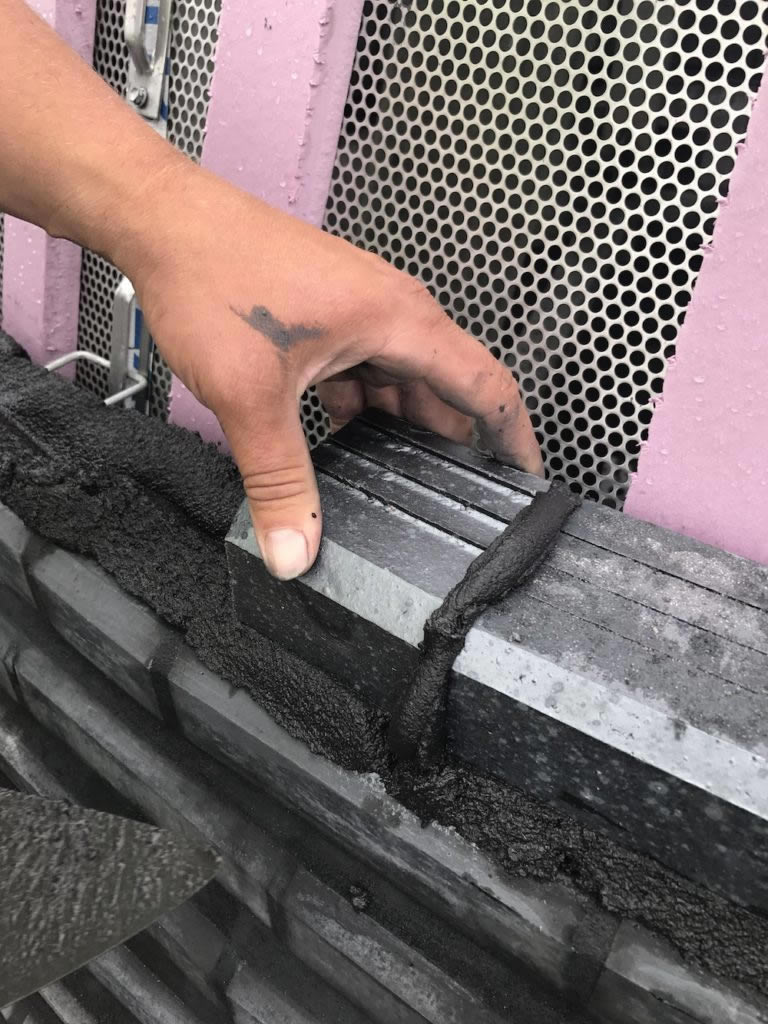
A dedication ceremony took place in July of 2018 to announce the completion of the new sculpture. The piece Marshall designed takes the aesthetic shape of an African talking drum that has been separated and disjointed. The two elements are stacked precariously atop one another, seemingly on the verge of toppling, and representative of an imbalanced legal system continually seeking to right itself.
According to Marshall, the talking drum was named so for its resemblance to human speech, as was used for such by the West Yoruba people for communicating over long distances by varying the pitch of the drum and using tone to mimic the patterns of vocalized speaking. It is for this reason that the sculpture’s form represents the importance of communication between groups of people, as well as both the need for and the difficulty in achieving a balanced justice system. The monument gives overdue recognition to this important chapter in Iowa history.
Specs of the Feat
While the Riverwalk area has been in a process of revitalization over the past decade, it continues to expand and attract locals and visitors alike- especially with the sculpture as its newest feature. Standing nearly 30 feet tall, it has surely become an architectural spectacle in the area. Marshall worked closely with Substance Architecture to explore the use of masonry, who sought the expertise of Seedorff Masonry, Inc. to ensure constructability of the project as well as long term performance.
Project Manager on the Seedorff Masonry team, Matt Banse says that the sculpture is made of manganese iron spot brick, which is supported by a steel moment frame structure. The ever-changing radial geometry of the sculpture is complemented by the brick which has a rich texture and tones of grey with a subtle shine and lends texture to the monument.
Originally the sculpture was to be clad with a fiber cement board. The material was switched to brick because the artist felt that a material like brick best represented the weight that he was trying to portray with the sculpture. More specifically, the artist wanted to use a black brick.
The design team selected an Endicott manganese iron-spot brick for approval by Kerry James Marshall. Endicott was chosen due to their status as one of the premier manufacturers of black brick in the nation, and their capacity to produce hand-crafted specials. This application, although a non-traditional application for brick masonry, achieves the weight and permanence through the sculpture to express Marshall’s design intention.
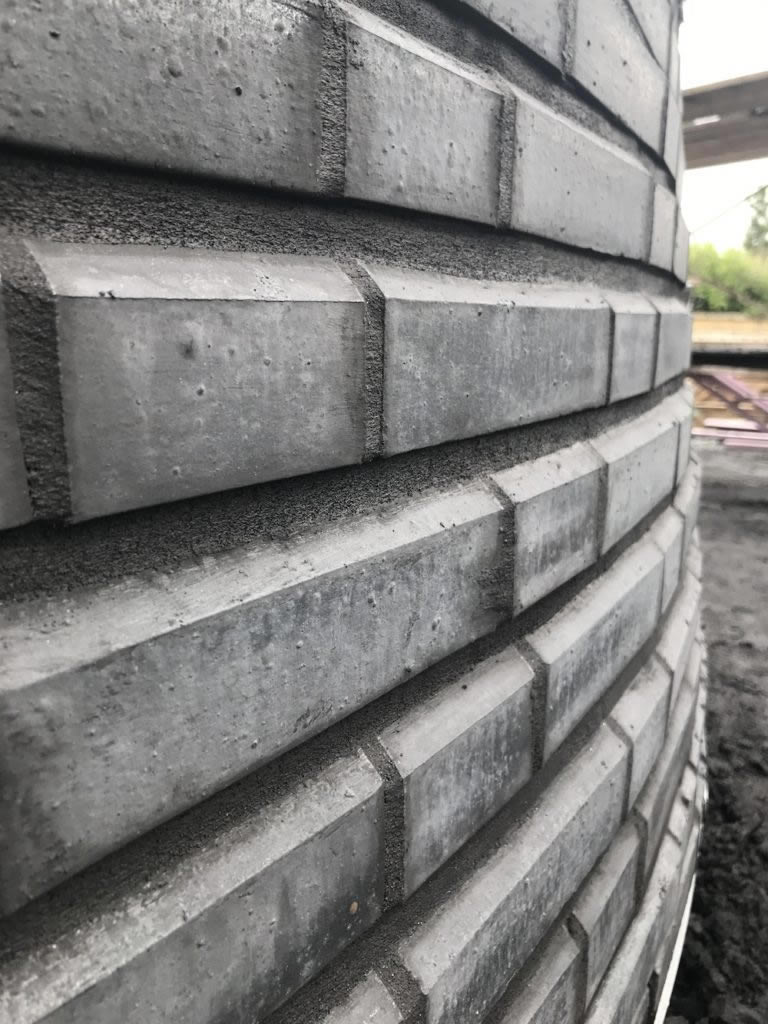
Structural steel was used for the main structure, then wrapped with a perforated stainless-steel sheeting to create the substrate behind the brick. The perforated sheet allowed the installer to shape the substrate and attach it to the frame, while also promoting the free movement of air to ventilate the interior space. Roof drains and vents were also utilized to regulate temperature and manage rainwater.
Detailed coordination with the design and construction team was critical in uncovering collaborative solutions for this project, and a variety of studies were undertaken early on in the process to determine the effect of bond and coursing. Based on the varying radius of each course and an eccentric conical shape, movement was necessarily introduced via the bond patterns selected.
Every brick was custom made and hand-cut in order to maintain consistency in the design and to ensure long-term performance. Banse says that the final design incorporates a Flemish bond pattern to accommodate the radial nature of the sculpture. Three expansion joints are incorporated in each drum to allow movement due to thermal variations and to serve as an aesthetic “reset” of the bond.
The header brick in the Flemish bond provides visual movement in two directions at varying paces, while the chamfered leading edge ensures performance, limits exposure for the public, and introduces interest with shadows and reflection at the bed joints.
In the lower drum, the chamfer creates the top leading edge of the units to shed water and discourage the temptation of the public to climb the sculpture. At the upper drum, the chamfer is inverted to mirror the surface and horizontal shadow lines below.
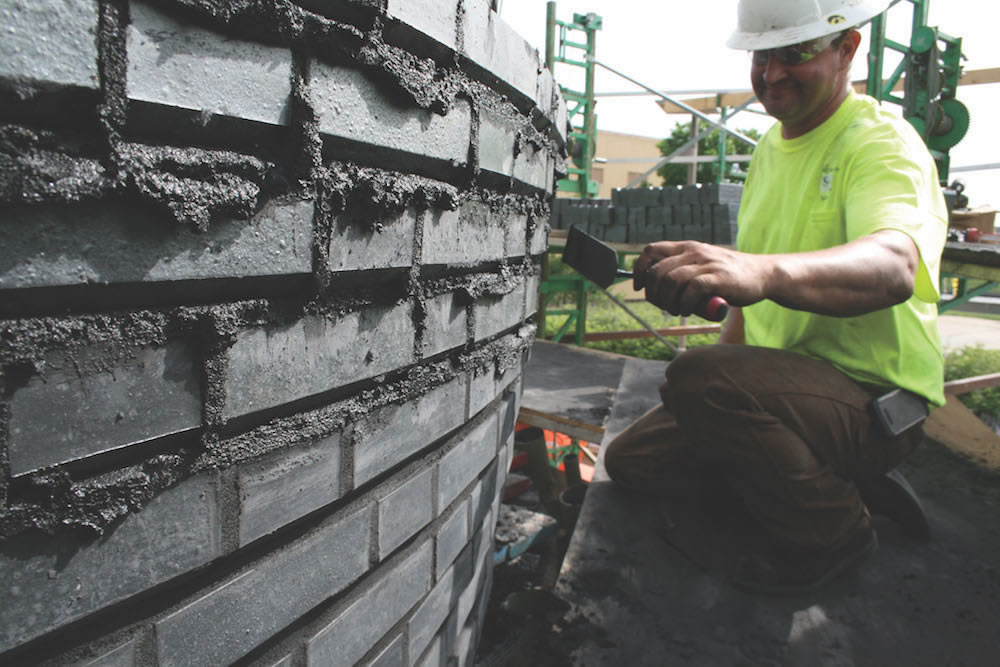
“Nearly every angle of the form is different, so you can’t just mass produce one brick and make that work. Every one of those bricks had to be cut by hand to make that cylindrical form consistent,” said Marshall. “The team of masons who they had working on the project was just masterful.”
Design Testing + Challenges
Similar to the first steps of many other projects of the twenty-first century, prior to the start of construction, a mockup was pursued to investigate constructability as well as aesthetics. Two panels represented the bottom and top drums, and the mockup was assembled on a platform to allow it to be transported to the actual site for viewing.
The panels were representative of the intended median radius, corbeling at the upper drum, and racking back in the lower drum. It was discovered that radial coursing presents unique challenges with movement, especially knowing that black brick in the upper Midwestern U.S. will experience large swings in temperature with seasonal fluctuations. The tapered modular stretchers were created with the intent to maintain consistency in the dimension of the head joints to promote compression of the mortar at installation and, therefore, bond.
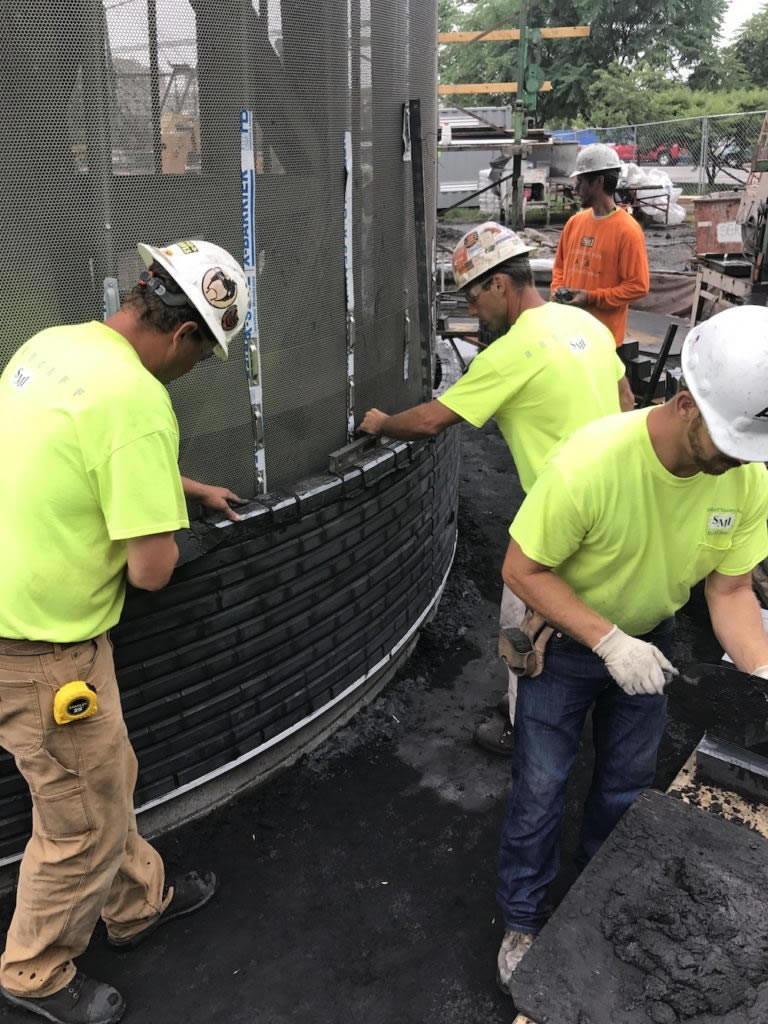
Due to the necessity of “end extruding” the units to incorporate the chamfered edge, coring of the units was not possible and striations in the top and bottom of the units were introduced to facilitate bond at the bed joints. When subject to elevated temperatures, the expansion of the brick on a radius also serves to place the head joints in tension as the assembly experiences a dimensional increase in length. In an effort to accommodate tensile forces and prevent cracking, adjustable ties and seismic wire were incorporated into the design.
According to Banse, there were four main challenges that arose during this project: time, geometry, custom materials, and the angle of the bottom drum.
The biggest challenge on this project was the compressed schedule. The Des Moines Public Art Foundation had already published and marketed a time and date for the public dedication, which gave Seedorff only 6 weeks to complete the masonry work on the project. According to Job Superintendent Dan Amble, “It seemed like the deadline was always looming.”
However, Amble and his team of four bricklayers and two laborers were able to tackle this challenge by sequencing the work to begin on the upper drum for speed, economy, and convenience. A non-typical approach for traditional masonry, this schedule eliminated potential damage and/or protection that would have been likely at the lower drum if work had begun at ground level.
Banse claimed that this method “created a system to work our way around the sculpture, with each craftsman assuming an individual task. The first bricklayer was responsible for spreading the mortar and laying the brick. Then, the second bricklayer followed the first around the radius, leveling the brick as he went.
The third bricklayer then ensured that the brick installation was plumb and a consistent dimension from the structure to give the wall its shape. And finally, the fourth bricklayer was responsible for tooling the mortar joints to create a consistent finish. In addition to the crew of four bricklayers, our laborers were responsible for mixing the mortar, stocking brick, and installing wall ties as the work progressed.”
The radial geometry of the structure was not easy to tackle with a rigid material like brick. With the brick on a radius, over an all-steel structure, expansion joints were critical because the brick and mortar would not only be succumbing to expansion horizontally but also outward expansion due to the radius. This allowed for the accommodation of growth, movement, and moisture.
The custom, hand-cut brick shapes required for the project meant a high cost and increased time spent preparing them. Banse mentioned that Endicott manufactured approximately 3 times the amount of brick necessary due to internal QC/QA standards, and saw subsequently low recovery rates. Every modular stretcher was hand cut and stacked by one individual.
Finally, the angle of the bottom drum. The north segment of the bottom drum contained a much more drastic angle as it racked back than the corresponding corbel in the top drum. Due to the severity of the angle, Amble and the crew opted to put 1” rigid insulation in the cavity to prevent the brick from tipping during installation.
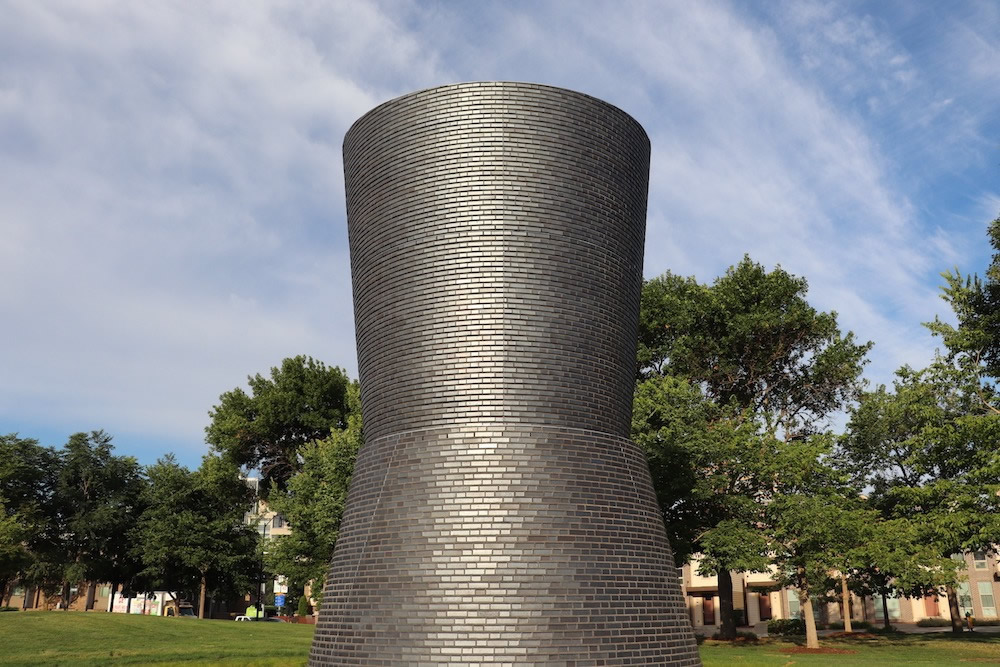
Recognition
In October of 2018 at the AIA Iowa Annual Convention, Seedorff Masonry, Inc. received two awards recognizing exceptional craftsmanship for their work on A Monumental Journey. The first was a merit award for Excellence in Craft, which commended the company for its skill and attention to detail given to this project. The second, the Golden Trowel Award from the Masonry Institute of Iowa.
AIA Iowa declared with the presentation of the Excellence in Craft Award, “We loved the story that was told about how the bricks were crafted… carving the bonding striations, hand trimming the bricks, the process to achieve the manganese iron spot flashing. The piece is so lovingly made that it just stops you in your tracks.”
From this acknowledgment alone, we can see how the implementation of this commemorative architectural installation is advocating for the celebration of those it represents- the founders of the National Bar Association would be so proud of the positive responses it has evoked. The labor of love manifested in the masonry has constructed more than a sculpture. It has constructed the memories of another American feat, a collection of moments in time of great magnitude, worthy of a long fought for celebration.
“These people were able to achieve something that made a difference in the lives of a lot of people,” Marshall said. “The organization should live on in the memories of people way past our time… The more we remember, the better.”